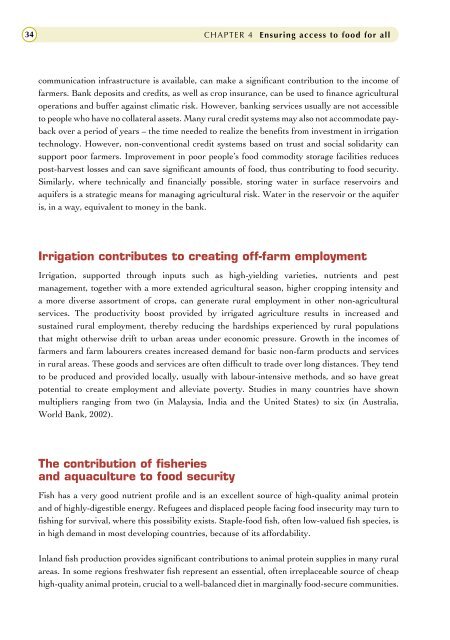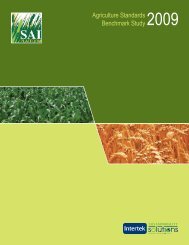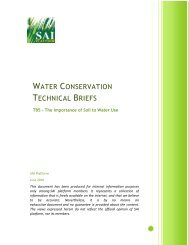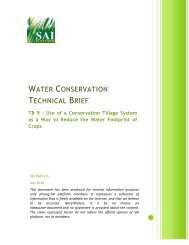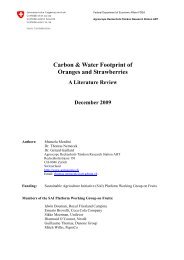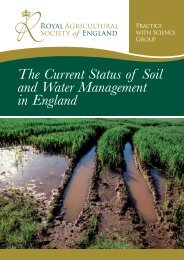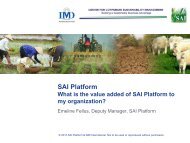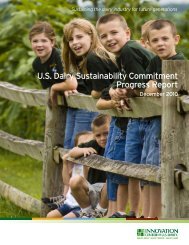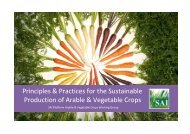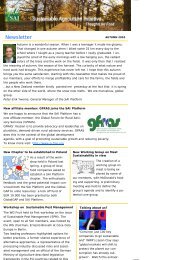Agriculture, food and water - FAO.org
Agriculture, food and water - FAO.org
Agriculture, food and water - FAO.org
Create successful ePaper yourself
Turn your PDF publications into a flip-book with our unique Google optimized e-Paper software.
34 CHAPTER 4 Ensuring access to <strong>food</strong> for all<br />
communication infrastructure is available, can make a significant contribution to the income of<br />
farmers. Bank deposits <strong>and</strong> credits, as well as crop insurance, can be used to finance agricultural<br />
operations <strong>and</strong> buffer against climatic risk. However, banking services usually are not accessible<br />
to people who have no collateral assets. Many rural credit systems may also not accommodate payback<br />
over a period of years – the time needed to realize the benefits from investment in irrigation<br />
technology. However, non-conventional credit systems based on trust <strong>and</strong> social solidarity can<br />
support poor farmers. Improvement in poor people’s <strong>food</strong> commodity storage facilities reduces<br />
post-harvest losses <strong>and</strong> can save significant amounts of <strong>food</strong>, thus contributing to <strong>food</strong> security.<br />
Similarly, where technically <strong>and</strong> financially possible, storing <strong>water</strong> in surface reservoirs <strong>and</strong><br />
aquifers is a strategic means for managing agricultural risk. Water in the reservoir or the aquifer<br />
is, in a way, equivalent to money in the bank.<br />
Irrigation contributes to creating off-farm employment<br />
Irrigation, supported through inputs such as high-yielding varieties, nutrients <strong>and</strong> pest<br />
management, together with a more extended agricultural season, higher cropping intensity <strong>and</strong><br />
a more diverse assortment of crops, can generate rural employment in other non-agricultural<br />
services. The productivity boost provided by irrigated agriculture results in increased <strong>and</strong><br />
sustained rural employment, thereby reducing the hardships experienced by rural populations<br />
that might otherwise drift to urban areas under economic pressure. Growth in the incomes of<br />
farmers <strong>and</strong> farm labourers creates increased dem<strong>and</strong> for basic non-farm products <strong>and</strong> services<br />
in rural areas. These goods <strong>and</strong> services are often difficult to trade over long distances. They tend<br />
to be produced <strong>and</strong> provided locally, usually with labour-intensive methods, <strong>and</strong> so have great<br />
potential to create employment <strong>and</strong> alleviate poverty. Studies in many countries have shown<br />
multipliers ranging from two (in Malaysia, India <strong>and</strong> the United States) to six (in Australia,<br />
World Bank, 2002).<br />
The contribution of fisheries<br />
<strong>and</strong> aquaculture to <strong>food</strong> security<br />
Fish has a very good nutrient profile <strong>and</strong> is an excellent source of high-quality animal protein<br />
<strong>and</strong> of highly-digestible energy. Refugees <strong>and</strong> displaced people facing <strong>food</strong> insecurity may turn to<br />
fishing for survival, where this possibility exists. Staple-<strong>food</strong> fish, often low-valued fish species, is<br />
in high dem<strong>and</strong> in most developing countries, because of its affordability.<br />
Inl<strong>and</strong> fish production provides significant contributions to animal protein supplies in many rural<br />
areas. In some regions fresh<strong>water</strong> fish represent an essential, often irreplaceable source of cheap<br />
high-quality animal protein, crucial to a well-balanced diet in marginally <strong>food</strong>-secure communities.


